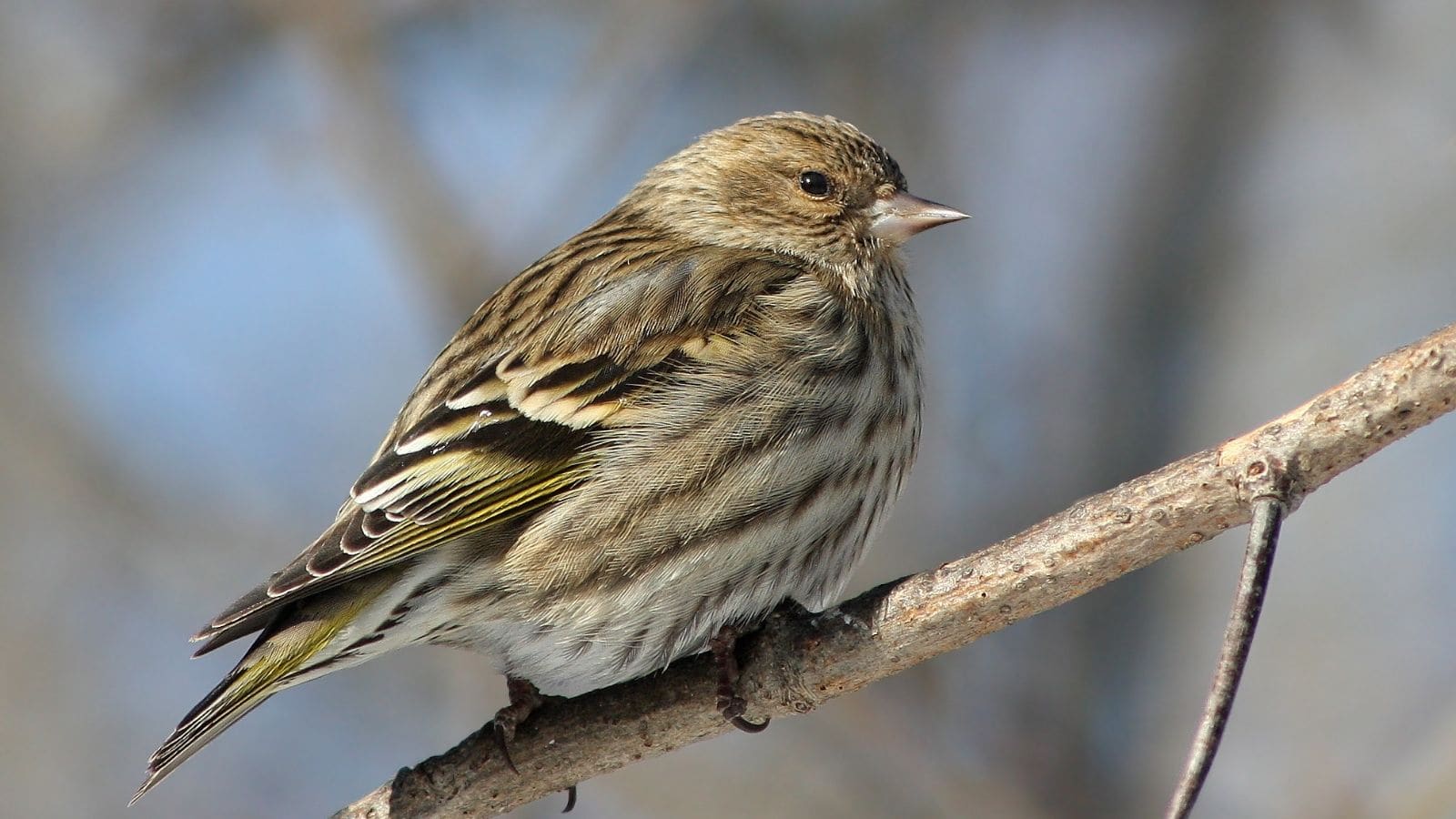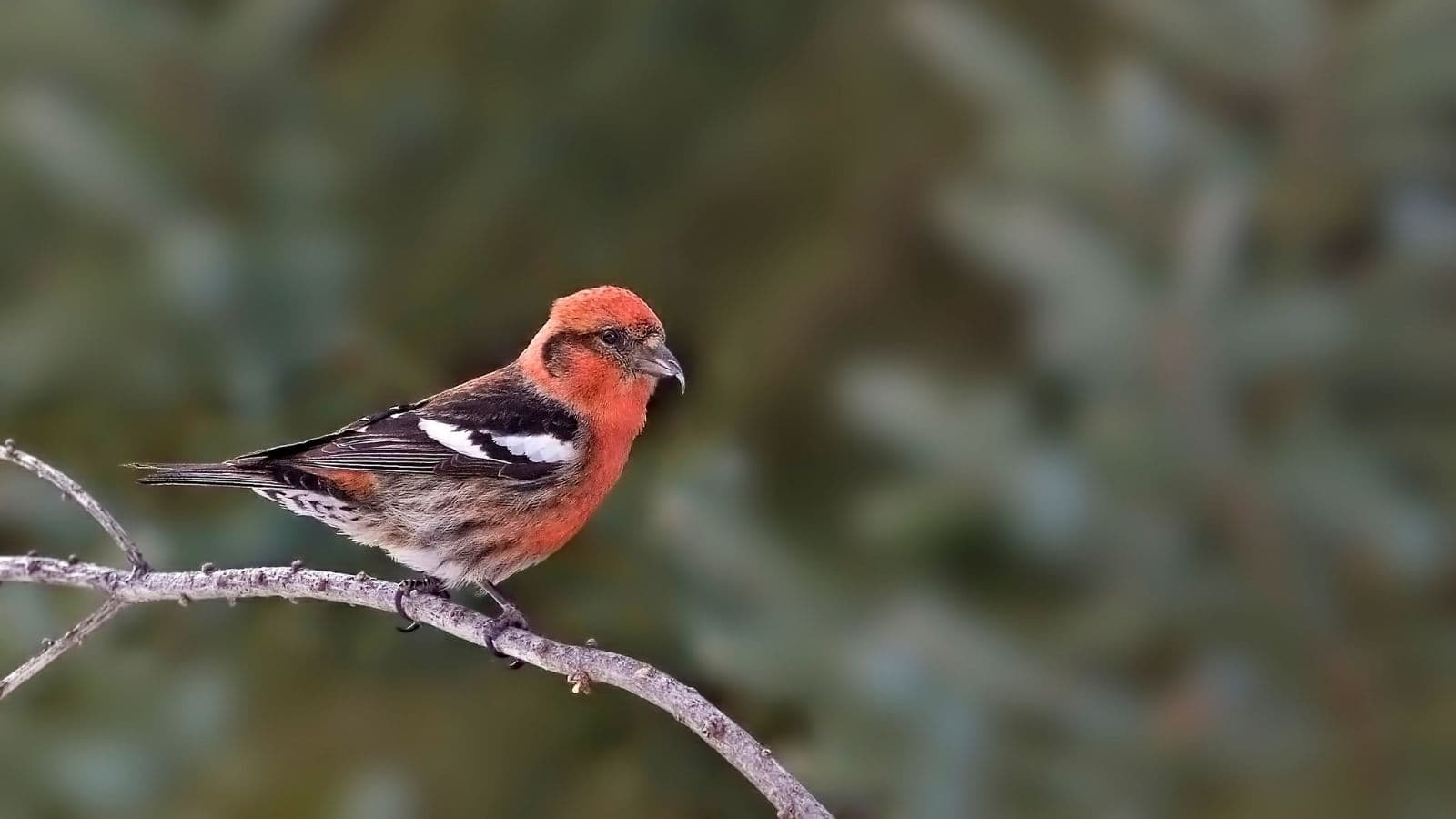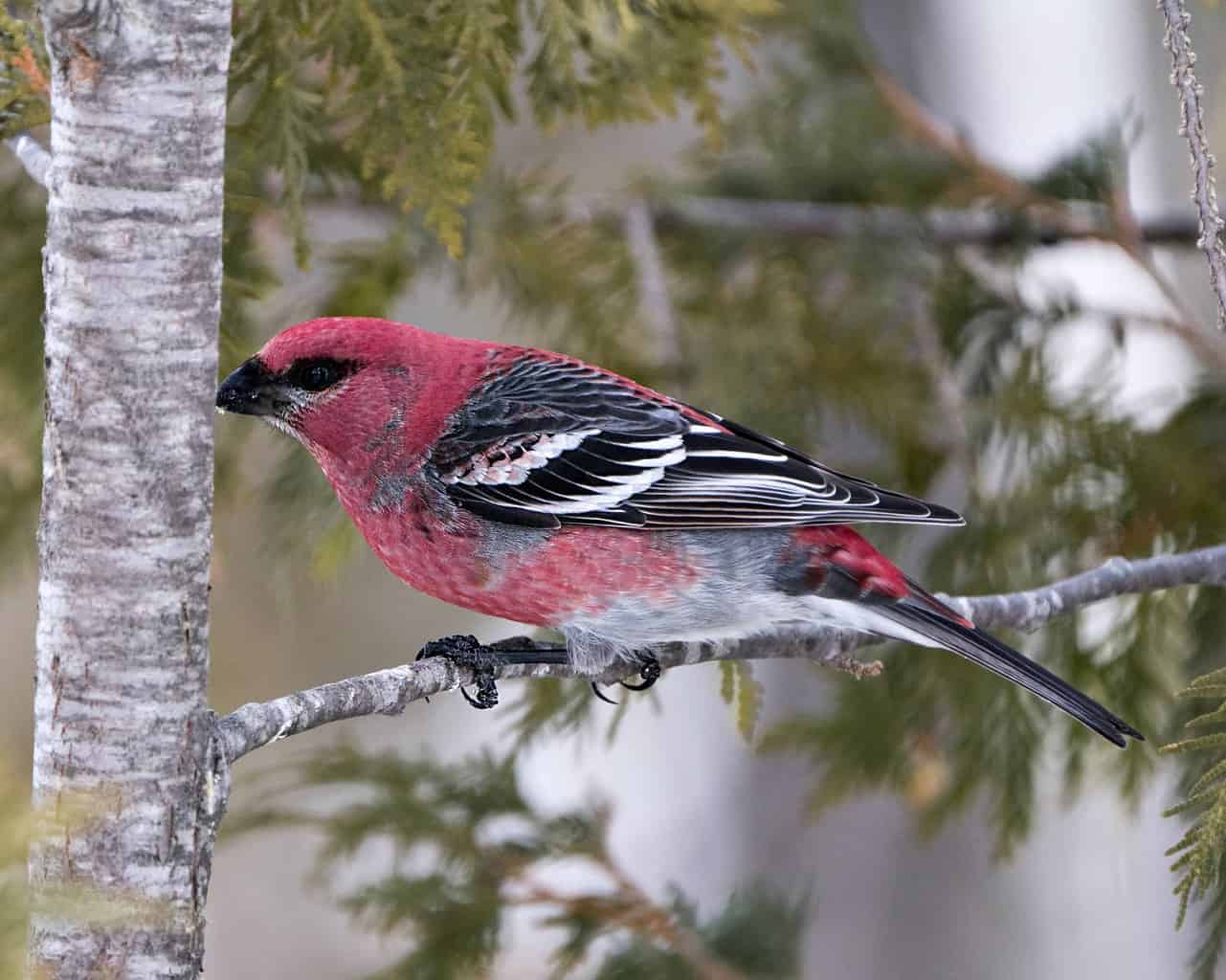The Empire State may be popular for its overflowing pigeon population, but the state as a whole is a haven for finches. There are 10 finches in New York you can spot on your next bird-watching adventure.
What makes finches so adaptable, anyway? A major part is their diet – these birds often eat a variety of insects, berries, flower buds, and seeds.
They’ll also nibble on maple sap or try some road salt. Unsurprisingly, such a diverse food supply means they can get comfortable just about anywhere!
My guide below will help you spot these hardy songbirds by their appearance, unique birdsong, and diet habits. I’ll also share some fun facts and tips on attracting them to your bird feeder.
House Finch

- Species Name: Haemorhous mexicanus
- Length: 13 cm to 14 cm
- Weight: 16 grams to 27 grams
- Wingspan: 20 cm to 25 cm
You don’t get much more adaptable than the house finch. In fact, it was illegal bird traders who released them in New York around 1940.
Appearance
The male house finch is a recognizable bird for its bold, rosy red head and back. He has brown wings and a gray conical bill.
The female house finch is a light gray-brown with speckles of white. She may look similar to a sparrow at a glance, but she has much lighter coloration.
Range
This beautiful bird has an impressive range, just as comfortable in shrubby areas as they are in urban environments. You’ll easily see this common species year-round in parks, gardens, and people’s backyards.
Diet
House finches love to eat a variety of foods such as flower buds, berries, and seeds. You’ll have no problem bringing them to your backyard with black oil sunflower seeds and millet.
However, these finches are rather territorial and don’t like sharing with other birds. As such, you may want to have separate feeders with different seeds if you want to see other finches.
Birdsong
These birds have a sweet and distinctive finch song composed of warbles and chirps. You’ll sometimes hear two-note calls of chwee-chr chwee-chr.
Fun Fact
The house finch is frequently confused with the purple finch due to sharing similar coloration. However, the latter finch is less common and not nearly as territorial.
Purple Finch

- Species Name: Haemorhous purpureus
- Length: 12 cm to 16 cm
- Weight: 18 grams to 32 grams
- Wingspan: 22 cm to 26 cm
Despite their common name and scientific name, the purple finch isn’t actually purple! The males boast the same red color as the house finch but with a few differences.
Appearance
Male purple finches are covered in a pinkish red that extends along their chest and back. They have brown wings and a bright white belly.
The female purple finch is light brown with a white eyebrow and white stomach. She’s covered in speckles and has a much smaller bill.
Range
The purple finch is also rather easy to spot in New York, though they tend to show up more commonly during breeding season. While they’re rare to see in the Big Apple, they’ll show up frequently in the state’s deciduous forests.
Diet
Purple finches enjoy a diverse diet of seeds, flower buds, and berries. They’ll also try a little nectar and don’t mind a free meal at backyard bird feeders.
Black oil sunflower seeds are some of their favorite treats. They do just as well on a platform feeder as they do at a tube feeder.
Birdsong
If you’re a fan of warbles, you’re in good hands. Purple finches let loose a long, lilting warble with repetitive twyr-twyr-rr notes.
Fun Fact
The purple finch is an irruptive species – this means they have unpredictable migration patterns that revolve around food availability.
American Goldfinch

- Species Name: Spinus tristis
- Length: 11 cm to 13 cm
- Weight: 11 grams to 20 grams
- Wingspan: 19 cm to 22 cm
If you’re a fan of watching birds at your backyard feeder, the American goldfinch is one of the most compelling. Their gorgeous coloration and social nature make them a real treat to observe.
Appearance
The male American goldfinch has striking plumage of yellow feathers, black wings, and white wing bars. His bright orange bill and black-capped head give him a charming profile.
However, his plumage will soften to an olive-yellow outside of breeding season.
The female American goldfinch is similar looking to the male once spring is over. She has a light yellow-brown body with the same black and white wings, but no black cap.
Range
American goldfinches show up year-round in the state, though their numbers crank up during the breeding season. While they’ll sometimes visit forests, they prefer weedy fields, shrubs, and orchards.
This is the kind of finch to keep an eye out for when going on a nature walk. American goldfinches are quite comfortable in New York’s many national parks and botanical gardens.
Diet
These finches spend much of their time diving in and out of shrubby areas to eat weed seeds. They enjoy a broad variety such as ragweed, dandelion, and alder.
However, they occasionally switch to berries or maple sap when their main food supply runs low.
You’ll have an easy time attracting them to your backyard with nyjer or sunflower seeds.
Birdsong
American goldfinches have a bright, happy song of rapid cheeps and whistles. Expect to hear a classic chwerpa-chwerpa-cherp.
Fun Fact
One of the most charming aspects of American goldfinches is their preference to travel in groups. These fascinating birds frequently find large groups foraging and chatting amongst each other.
Pine Siskin

- Species Name: Spinus pinus
- Length: 11 cm to 14 cm
- Weight: 12 grams to 18 grams
- Wingspan: 18 cm to 22 cm
This charming fellow can be a little tricky to spot due to their similarity with sparrows, but there are a few key differences.
Appearance
The pine siskin is a round fellow with a light brown body, white belly, and speckled chest. He often has a dusting of yellow and even yellow-green along his wings.
The female pine siskin looks extremely similar to the male but with less yellow. If you can’t tell the difference, don’t worry – even experienced birders get them confused!
Range
Another reason why these finches are trickier to spot is their limited range. They usually show up in New York during the winter months, though you’ll find the occasional bird who stays year-round.
Pine siskins live up to their name by sticking to heavily forested areas where they can eat their main food supply.
Diet
Pine siskins depend heavily on a seed diet. They mostly eat alder, birch, spruce, and thistle seeds.
However, they’ll sometimes nibble along roadsides for salt or snatch a few insects. If you want to attract them to your bird feeder, use nyjer or suet during the winter.
Birdsong
The pine siskin’s call is a delightful squeal that sounds like a very long tzweeeee.
Fun Fact
These finches are more opportunistic, switching up their feeding and even breeding habits on a yearly basis.
Common Redpoll

- Species Name: Acanthis flammea
- Length: 12 cm to 14 cm
- Weight: 11 grams to 20 grams
- Wingspan: 19 cm to 22 cm
A rarer finch than others on this list, the common redpoll is one you don’t want to miss. Their stark coloration is one of the most beautiful sights during the winter season.
Appearance
Adult males are quite stunning with their bright red foreheads, pink breasts, and round brown bodies. They have a surprisingly tiny bill for a finch.
The female common redpoll looks similar to the male but without the pink chest.
Range
Since they usually prefer very cold environments, the common redpoll shows up in New York only during the winter months. Keep a close eye out once fall hits if you’re in a forested area.
Common redpolls love boreal forests where they can forage for their primary food supply.
Diet
Birch and alder seeds are the preferred food of the common redpoll. While they don’t show up often at feeders, they may visit if you stay stocked up on fresh thistle.
Birdsong
The common redpoll’s song is a light and airy one, composed of repetitive chr-chr-chrs.
Fun Fact
The common redpoll also goes by the name the ‘mealy redpoll’.
Hoary Redpoll

- Species Name: Acanthis hornemanni
- Length: 12 cm to 14 cm
- Weight: 11 grams to 20 grams
- Wingspan: 22 cm to 23 cm
I couldn’t possibly leave out one of the most adorable finches in the finch family. While they’re an accidental species in New York, their occasional appearances are unforgettable.
Appearance
The hoary redpoll looks quite similar to the common redpoll but with a much brighter body. They also have a tendency to fluff up their body feathers into a little ball to withstand the cold.
Female hoary redpolls look similar to the males but with white breasts and fewer streaks.
Range
The hoary redpoll regularly makes their home in the arctic tundra, though they’ll visit evergreen forests once it gets warm. Because of their hardy nature, they visit New York rarely and usually during winter.
Diet
Similar to the common redpoll, the hoary redpoll is quite fond of birch and alder seeds. They don’t show up at feeders often, but if you do see them, it’ll be during the winter months.
Birdsong
The hoary redpoll song is sharp and lively with piercing notes. You’ll likely hear some rapid chit-chit-chits or cheet-cheets.
Fun Fact
Like the common redpoll, the hoary redpoll also goes by different names. They’re sometimes called the Arctic redpoll due to their love of freezing environments.
Red Crossbill

- Species Name: Loxia curvirostra
- Length: 14 cm to 17 cm
- Weight: 40 grams
- Wingspan: 25 cm to 27 cm
This stocky finch is a little larger than other members of the finch family. As it stands, that’s not the only reason they’ll stand out!
Appearance
The male red crossbill has a bold red or orange-red body with dark wings and thin white wing bars. Their unique criss-crossed beak has been the subject of much fascination for biologists.
Female red crossbills boast the same beak but have gray bodies. She’ll often have a hint of yellow or yellow-orange on her back and rump.
Range
Red crossbills usually stick to dense forests where they can use their powerful bills to dine endlessly on seeds. Their unique beaks help them dig into pinecones to tug out their main food supply.
Expect to see these birds in New York during the winter months, though they sometimes show up during fall. They’re rather scarce in the southern portion of the state.
Diet
Pine, fir, and spruce seeds are their favorite foods to eat. They’re not as fond of bird feeders as American goldfinches and house finches, but they may still stop by.
Stock up on fresh sunflower seeds during the winter and keep an eye out for their crossed beak.
Birdsong
Red crossbills have a rather sharp song of chrr-a chrr-a chrr-a. They sound like the squeaking noise you make when wiping down a dirty window.
Fun Fact
If you got it, flaunt it. Their fascinating beak shape is what people originally noticed about them since the Latin word of their scientific name curvirostra means ‘curved bill’.
White-Winged Crossbill

- Species Name: Loxia leucoptera
- Length: 15 cm to 17 cm
- Weight: 24 grams to 26 grams
- Wingspan: 26 cm to 28 cm
This finch is a rarity in New York state, but determined bird watchers may glimpse them during their usual migration patterns.
Appearance
The male white-winged crossbill looks similar to the red crossbill, but keep a sharp eye out. They have darker wings and much larger white wing bars.
However, they do have the same crossed beak shape as their red crossbill cousin.
The female white-winged crossbill has a light gray-brown body with dark wings and a speckled stomach.
Range
These finches are fond of coniferous forests where they can use their criss-crossed beak to dig out seeds. The white-winged crossbill range sometimes has them showing up during the winter months, but also during early spring migrations.
Diet
These finches live almost entirely on seeds, particularly tamarack and spruce. They may be tempted to seek out a bird feeder if their usual food supply runs low.
Try sunflower seeds to invite them to your backyard. If you’re lucky, you may see them forage for food in flocks!
Birdsong
Their birdcall is a sharp and lively one, composed of very repetitive chee-chee-chee or chr-chr-chrs.
Fun Fact
Interestingly enough, the white-winged crossbill sometimes nibbles on road salt.
Pine Grosbeak

- Species Name: Pinicola enucleator
- Length: 20 cm to 25 cm
- Weight: 57 grams
- Wingspan: 33 cm
These stocky birds are some of the biggest in the finch family. In fact, they’re so large some bird watchers think they’re another bird species entirely.
Appearance
The male pine grosbeak is a stunning bird with deep red plumage, dark wings, and white wing bars. He has a dark beak and a notched tail that looks like a little flag.
Adult females have a completely different coloration. Her body is a light gray with a sprinkle of yellow or yellow-orange on her head.
Range
Coniferous forests are the stomping grounds of the pine grosbeak, but they’re still prone to wandering. While they don’t show up in New York often, you may glimpse them in the northern portion of the state during non-breeding season.
Diet
These beautiful finches will try a little bit of everything. They enjoy a tasty mixture of berries, flower buds, seeds, and insects.
Sunflower seeds are an ideal food to invite them over, but make sure to use a platform feeder. These finches are too large for perching or tube feeders.
Birdsong
The pine grosbeak song sounds more like casual whistling than it does a chirp or cheep. You’ll also hear light, airy warbles.
Fun Fact
Pine grosbeaks are rather nomadic and will often change their living habits entirely to find a better food source.
Gray-Crowned Rosy-Finch

- Species Name: Leucosticte tephrocotis
- Length: 14 cm to 21 cm
- Weight: 22 grams to 60 grams
- Wingspan: 33 cm
These plump finches are pretty rare in New York, but I couldn’t possibly leave them off the list. If you have a sharp eye, you may be able to spot this accidental species.
Appearance
The male gray-crowned rosy-finch is rather large, boasting a beautiful dark gray-brown body flecked with pink. They have dark legs and a bright yellow bill.
The male will often have a bright gray head, though some will be darker.
The female gray-crowned rosy-finch has a subtle brown body with a pink rump and dark wings.
Range
The reason these birds rarely show up in New York is because they prefer arctic tundra and wide, snowy fields. However, they’re not opposed to visiting well-stocked bird feeders.
Diet
This finch is usually hard at work foraging for insects, particularly worms burrowed deep underground. They’ll also eat thistle and mustard seeds.
If you’re patient, you may glimpse one at your bird feeder. Try attracting these finches with sunflower seeds and make sure you have spacious platform feeders.
Birdsong
This robust bird has quite the call, letting loose dynamic warbles and chitters that sound like a lively conversation at the marketplace.
Fun Fact
This bird has quite a history. It’s possible the gray-crowned rosy-finch’s ancestors descended from Asia before evolving further north.
New York Is One of the Most Dynamic Birdwatching Locations
New York is a dynamic birdwatching location no matter where you go. Urban environments will have a few finches, while the state’s forests will boast even more.
I recommend keeping your camera on you at all times. You never know when one of the accidental finch species like the gray-crowned rosy-finch will show up!
Curious to learn more about New York’s bird population? Our guide on birds in New York has birds of prey, songbirds, and more.

